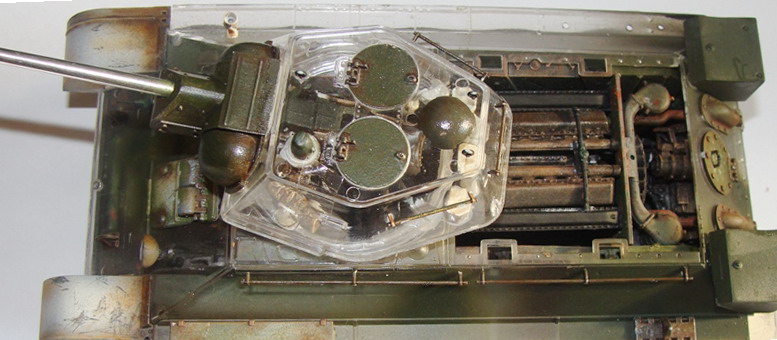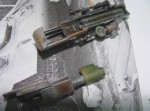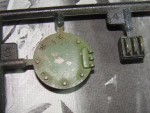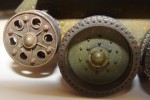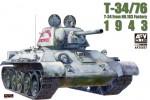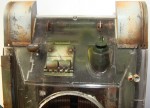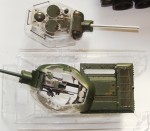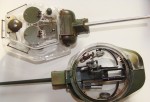1⁄35AFV Club's T-34/76 1943 (item AF 35S56)
...
Post a Comment
introduction
After reviewing the first two T-34 releases from AFV Club, I couldn't wait to build the newest addition: the T-34/76 1943 Model.the build
The T-34/76 was simplicity itself, and construction of the kit, even with full interior detail, is straight-forward. AFV Club tank kits are famous for their working suspensions, and this is no exception. The working coil spring assemblies are inserted into their housings in the inner hull walls. One end is connected to a pin on each torsion arm, which pivots by having its shaft trapped with a cap on the inside of the hull. The whole assembly is clever and simple. The outstanding feature of this kit is its beautifully-detailed V2 diesel engine/transmission assembly. Covering two whole pages of the instructions, building it is a mini-kit in itself! You'll almost want to torque-down the cylinder head bolts and tighten leaky hose clamps when it's complete. Super-detailers may want to add the twelve fuel injection lines from fine wire, and hollow-out the exhaust pipes with a drill-bit. The engine compartment is nicely finished with a separate access hatch and cooling slats (which are angled within their slots when opened). The rear deck is then finished-off with a photo-etched mesh grille, the contour of which is achieved with locating pins and holes. The road wheels with their separate, black styrene tires (not vinyl, thank God!) are next, held to their axles with hubcaps. I used the separately-available individual track links from AFV Club, which are excellent for this kit, though the photos (Lower Right) show these tracks assembled on the early, 1942 model. I really didn't want to cement the vinyl tracks down atop each road wheel, and love the detail provided by the indy links. Though thin and fragile, the kit-supplied vinyl tracks are among the best I’ve seen recently. I found that regular cement isn’t strong enough for these vinyl tracks, so CA cement may be required for a good bond. They are extremely supple –so much so, that extreme care must be taken not to melt them with over-use of cement. Nice touches to the exterior hull include tiny, separately-moulded tie-down loops and multi-part tool boxes. The driver's hatch, with clear episcopes, is particularly well done. Construction of the 1943 Model turret, another mini-kit in itself, covers the final page and a half of the instructions. Every detail is present –down to the separate recoil buffers and breech block of the 76mm gun. All this work will be displayed through the clear turret walls and roof. I recommend painting all these small interior details before fitting to the turret interior, as it will be impossible later, without getting paint on the clear parts. I did leave-off the turret side wall vision ports, as the cement would be visible on the clear parts. I'll have to paint them opaque and attach them later.conclusion
See photos for differences between the early (1942), single hatch and two-hatch (1943 model), turrets. The thing I didn't like are the few pin marks visible on the inside faces of some of the clear upper hull and turret parts -a problem that has to be overcome in any of these "visible" kits. Unlike some others I've built (Tristar Panzer IA), the quality and clarity of these clear parts is top-notch. The backs of some interior details, such as the hull fuel tanks and machine gun ammo racks, are visible through the clear plastic. To overcome this, I simply airbrushed selected areas of the exterior, with more opaque coats of paint over areas I didn't want to remain visible from the outside. I just have a few more details to add, and then I cannot wait for this kit to take its place of honor in my display case. About the only thing missing would be some 76mm brass ammunition. For a kit with a full interior, it is a surprisingly simple build, with clear instructions, no fit issues, and very little flash clean-up. As a "visible" kit, it should be noted that some exterior weld and casting texture is lacking, should you decide to paint the exterior completely opaque. The only rivals to this kit are the expensive interior conversion set by Verlinden, the giant 1/16th scale kits from Trumpeter, or the smaller 1/48th scale offerings from Hobby Boss with their troublesome tracks. My sincere thanks to AFV Club for the review sample!further reading
Follow the step-by-step build of my T-34/76 (1942 Model) in my Build Log.Copyright ©2021 by Ted Hayward. Images and/or videos also by copyright holder unless otherwise noted. The views and opinions expressed herein are solely the views and opinions of the authors and/or contributors to this Web site and do not necessarily represent the views and/or opinions of Armorama, KitMaker Network, or Silver Star Enterrpises. All rights reserved. Originally published on: 2010-04-22 00:00:00. Unique Reads: 22830




